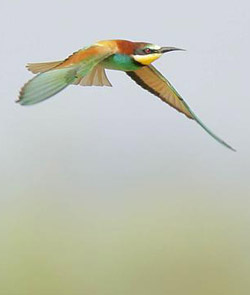Soaring is better than flapping

European bee-eater during flight.<br>Image: Jorge Rodrigues<br>
Large birds, such as storks, save energy on the flight to their wintering grounds by soaring through the air on thermal currents. Until now, however, we knew nothing about the flight patterns of small migrating songbirds, such as whether they flap their wings or soar and whether these styles of flight allow them to save energy. Now, a team of scientists at the Max Planck Institute for Ornithology in Radolfzell, Ben-Gurion-University of the Negev, and Hebrew University of Jerusalem have tracked the movement of European bee-eaters (Merops apiaster) along the Africa-Eurasia migration flyway with the help of tiny radio transmitters. Analysing measurements of heart rate, flight speed and flying style, they found out that these small birds also soars. Further, they found that the birds fly just as quickly when soaring as when flapping their wings, while using as little energy as it takes to sit in its nest. (Published in PloSOne 11, November 2010)
When we think of birds gliding majestically through the sky without beating their wings, we imagine large species like storks or hawks searching silently for prey. The flight patterns of large birds have been well studied. Ornithologists know how quickly and how far they fly, and how often they flap or soar while in flight. However, much less is known about these patterns in smaller birds. Until recently, it was thought that small birds were not able to glide and save energy in the same way, due to their smaller musculature and wings. Gliding would reduce the flight speed, so it was assumed.
In a recently published study, scientists at the Ben-Gurion University of the Negev and the Hebrew University of Jerusalem, along with Martin Wikelski, director of the Max Planck Institute for Ornithology in Radolfzell, determined for the first time the energy use of small songbirds in the wild. The researchers attached tiny radio transmitters onto the backs of European bee-eaters (Merops apiaster) caught in Israel to record their wing beat frequency, heart rate and flight speed. In order to estimate the birds’ energy use, they determined in the laboratory that the birds’ heart rate increased with oxygen consumption, and therefore the heart rate measurements indicate the birds’ energy use while flying.
“Analysing the data, we were surprised to see that bee-eaters often switch between soaring and flapping, and also that the frequency of heart beats while gliding was only as half what it was while flapping,” says Martin Wikelski. “The birds needed the same amount of energy while soaring or gliding as they did when they were resting on a branch or in a nest.” In contrast, previous studies with larger birds showed that energy use was at least 30 percent higher when the birds were gliding than when they were resting. Thus, soaring and gliding flight means a considerably higher savings of energy for small migrating birds than for larger species. In addition, the scientists did not find any loss of flight speed when birds were gliding.
The results of this study not only provide an answer to the question of whether small migrating birds can soar during their long journey, but also show that they travel just as fast while doing so and use less energy.
[LA/SD]
Original work:
Nir Sapir, Martin Wikelski, Marshall D. McCue, Berry Pinshow, Ran Nathan
Flight modes in migrating European bee-eaters: Heart rate may indicate low metabolic rate during soaring and gliding
PloSOne 5(11): e13956.doi:10.1371/journal.phone.0013956
Contact:
Nir Sapir
The Hebrew University of Jerusalem, Department of Evolution, Systematics and Ecology, Jerusalem, Israel
Tel.: +972 2 6586-080
Fax: +972 2 6584-655
E-mail: Nir.sapir@mail.huji.ac.il
Prof. Dr. Martin Wikelski
Max Planck Institute for Ornithology, Radolfzell
Tel.: +49 7732 1501-62
E-mail: martin@orn.mpg.de
Leonore Apitz, Press and Public Relations
Max Planck Institute for Ornithology, Radolfzell
Tel.: +49 7732 1501-74
E-mail: apitz@orn.mpg.de
Media Contact
More Information:
http://www.mpg.de/english/All latest news from the category: Life Sciences and Chemistry
Articles and reports from the Life Sciences and chemistry area deal with applied and basic research into modern biology, chemistry and human medicine.
Valuable information can be found on a range of life sciences fields including bacteriology, biochemistry, bionics, bioinformatics, biophysics, biotechnology, genetics, geobotany, human biology, marine biology, microbiology, molecular biology, cellular biology, zoology, bioinorganic chemistry, microchemistry and environmental chemistry.
Newest articles

Silicon Carbide Innovation Alliance to drive industrial-scale semiconductor work
Known for its ability to withstand extreme environments and high voltages, silicon carbide (SiC) is a semiconducting material made up of silicon and carbon atoms arranged into crystals that is…

New SPECT/CT technique shows impressive biomarker identification
…offers increased access for prostate cancer patients. A novel SPECT/CT acquisition method can accurately detect radiopharmaceutical biodistribution in a convenient manner for prostate cancer patients, opening the door for more…

How 3D printers can give robots a soft touch
Soft skin coverings and touch sensors have emerged as a promising feature for robots that are both safer and more intuitive for human interaction, but they are expensive and difficult…





















